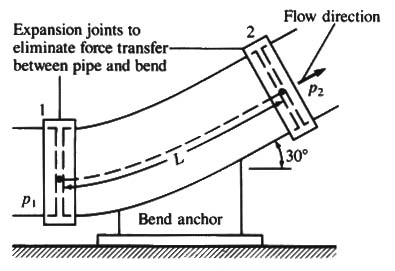CIV E 444 - APPLIED HYDRAULICS
FALL 2009
HOMEWORK No. 8
- An orifice is to be designed to have a change in pressure of Δp =
50 kPa across the orifice, for a discharge of Q = 3 m3/s in a pipe of diameter D = 1.2 m.
The temperature of the water is 15oC. What orifice diameter (to the nearest centimeter, by excess) will yield the desired discharge?

- Water flows through a venturi meter that has a 30-cm throat. The venturi meter is in a 60-cm diameter pipe.
What deflection will occur in a mercury-water manometer connected between the upstream and throat sections if the discharge is 0.6 m3/s?
Assume T = 20oC.

- A 30o vertical bend in a 2-ft diameter pipe carries water at the rate of 30 cfs.
The pressure at the lower end on the bend is p1 = 10 psi, at an elevation of 100 ft.
The pressure at the upper end is p2 = 8 psi, at an elevation of 103 ft.
The bend is 5-ft long and it weighs 300 lbs by itself. Determine the magnitude and direction of the force
that must be exerted by the anchor on the bend to hold it in position.

- Determine the discharge through the hydraulic system shown below.
Assume entrance loss coefficient Ke = 0.12 and bend loss coefficient Kb = 0.35.
Locate the point of maximum and minimum pressures along the line.
Calculate the maximum and minimum pressures.
